BMP6005 - Analysing Employee Relations Impact on Stakeholders
VerifiedAdded on 2023/06/05
|12
|3424
|434
Report
AI Summary
This report explores the value and importance of employee relations within an organization, using Debenhams as a specific example. It covers key aspects such as employee engagement, satisfaction, and retention, along with the fundamentals of employment law, including the Minimum Wage Act and the Equality Act 2010. The report provides suggestions for improving employee relations and delves into the rights, duties, and obligations of both employers and employees, including discussions on psychological contracts and work-life balance. A stakeholder analysis is conducted, identifying and prioritizing key stakeholders such as government, employees, shareholders, and customers. The report concludes with an analysis of the positive and negative impacts of employee relations on various stakeholders, emphasizing the importance of fostering a positive work environment and maintaining open communication channels.

Work and the
Employment relationship
Employment relationship
Paraphrase This Document
Need a fresh take? Get an instant paraphrase of this document with our AI Paraphraser
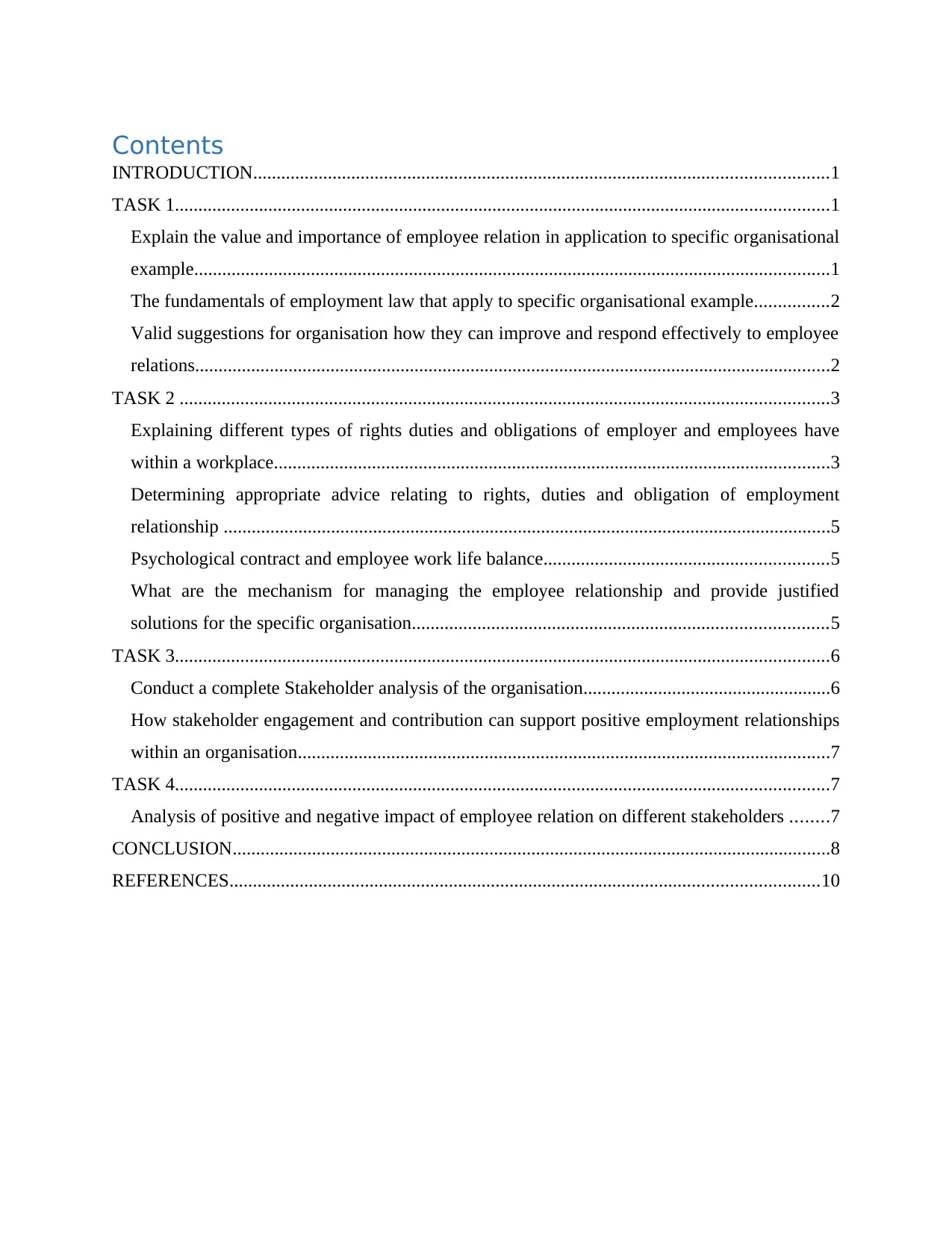
Contents
INTRODUCTION...........................................................................................................................1
TASK 1............................................................................................................................................1
Explain the value and importance of employee relation in application to specific organisational
example........................................................................................................................................1
The fundamentals of employment law that apply to specific organisational example................2
Valid suggestions for organisation how they can improve and respond effectively to employee
relations........................................................................................................................................2
TASK 2 ...........................................................................................................................................3
Explaining different types of rights duties and obligations of employer and employees have
within a workplace.......................................................................................................................3
Determining appropriate advice relating to rights, duties and obligation of employment
relationship ..................................................................................................................................5
Psychological contract and employee work life balance.............................................................5
What are the mechanism for managing the employee relationship and provide justified
solutions for the specific organisation.........................................................................................5
TASK 3............................................................................................................................................6
Conduct a complete Stakeholder analysis of the organisation.....................................................6
How stakeholder engagement and contribution can support positive employment relationships
within an organisation..................................................................................................................7
TASK 4............................................................................................................................................7
Analysis of positive and negative impact of employee relation on different stakeholders ........7
CONCLUSION................................................................................................................................8
REFERENCES..............................................................................................................................10
INTRODUCTION...........................................................................................................................1
TASK 1............................................................................................................................................1
Explain the value and importance of employee relation in application to specific organisational
example........................................................................................................................................1
The fundamentals of employment law that apply to specific organisational example................2
Valid suggestions for organisation how they can improve and respond effectively to employee
relations........................................................................................................................................2
TASK 2 ...........................................................................................................................................3
Explaining different types of rights duties and obligations of employer and employees have
within a workplace.......................................................................................................................3
Determining appropriate advice relating to rights, duties and obligation of employment
relationship ..................................................................................................................................5
Psychological contract and employee work life balance.............................................................5
What are the mechanism for managing the employee relationship and provide justified
solutions for the specific organisation.........................................................................................5
TASK 3............................................................................................................................................6
Conduct a complete Stakeholder analysis of the organisation.....................................................6
How stakeholder engagement and contribution can support positive employment relationships
within an organisation..................................................................................................................7
TASK 4............................................................................................................................................7
Analysis of positive and negative impact of employee relation on different stakeholders ........7
CONCLUSION................................................................................................................................8
REFERENCES..............................................................................................................................10
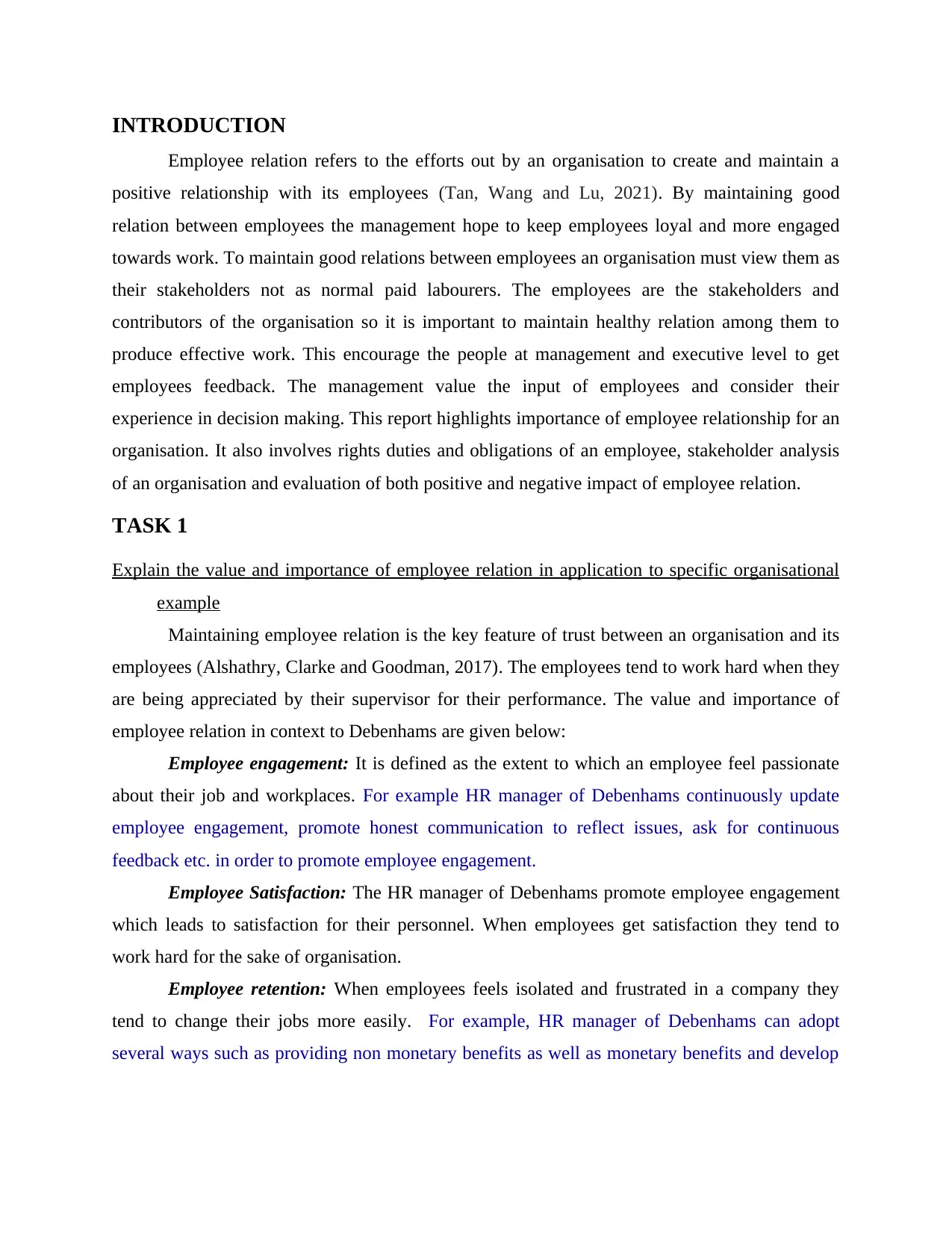
INTRODUCTION
Employee relation refers to the efforts out by an organisation to create and maintain a
positive relationship with its employees (Tan, Wang and Lu, 2021). By maintaining good
relation between employees the management hope to keep employees loyal and more engaged
towards work. To maintain good relations between employees an organisation must view them as
their stakeholders not as normal paid labourers. The employees are the stakeholders and
contributors of the organisation so it is important to maintain healthy relation among them to
produce effective work. This encourage the people at management and executive level to get
employees feedback. The management value the input of employees and consider their
experience in decision making. This report highlights importance of employee relationship for an
organisation. It also involves rights duties and obligations of an employee, stakeholder analysis
of an organisation and evaluation of both positive and negative impact of employee relation.
TASK 1
Explain the value and importance of employee relation in application to specific organisational
example
Maintaining employee relation is the key feature of trust between an organisation and its
employees (Alshathry, Clarke and Goodman, 2017). The employees tend to work hard when they
are being appreciated by their supervisor for their performance. The value and importance of
employee relation in context to Debenhams are given below:
Employee engagement: It is defined as the extent to which an employee feel passionate
about their job and workplaces. For example HR manager of Debenhams continuously update
employee engagement, promote honest communication to reflect issues, ask for continuous
feedback etc. in order to promote employee engagement.
Employee Satisfaction: The HR manager of Debenhams promote employee engagement
which leads to satisfaction for their personnel. When employees get satisfaction they tend to
work hard for the sake of organisation.
Employee retention: When employees feels isolated and frustrated in a company they
tend to change their jobs more easily. For example, HR manager of Debenhams can adopt
several ways such as providing non monetary benefits as well as monetary benefits and develop
Employee relation refers to the efforts out by an organisation to create and maintain a
positive relationship with its employees (Tan, Wang and Lu, 2021). By maintaining good
relation between employees the management hope to keep employees loyal and more engaged
towards work. To maintain good relations between employees an organisation must view them as
their stakeholders not as normal paid labourers. The employees are the stakeholders and
contributors of the organisation so it is important to maintain healthy relation among them to
produce effective work. This encourage the people at management and executive level to get
employees feedback. The management value the input of employees and consider their
experience in decision making. This report highlights importance of employee relationship for an
organisation. It also involves rights duties and obligations of an employee, stakeholder analysis
of an organisation and evaluation of both positive and negative impact of employee relation.
TASK 1
Explain the value and importance of employee relation in application to specific organisational
example
Maintaining employee relation is the key feature of trust between an organisation and its
employees (Alshathry, Clarke and Goodman, 2017). The employees tend to work hard when they
are being appreciated by their supervisor for their performance. The value and importance of
employee relation in context to Debenhams are given below:
Employee engagement: It is defined as the extent to which an employee feel passionate
about their job and workplaces. For example HR manager of Debenhams continuously update
employee engagement, promote honest communication to reflect issues, ask for continuous
feedback etc. in order to promote employee engagement.
Employee Satisfaction: The HR manager of Debenhams promote employee engagement
which leads to satisfaction for their personnel. When employees get satisfaction they tend to
work hard for the sake of organisation.
Employee retention: When employees feels isolated and frustrated in a company they
tend to change their jobs more easily. For example, HR manager of Debenhams can adopt
several ways such as providing non monetary benefits as well as monetary benefits and develop
⊘ This is a preview!⊘
Do you want full access?
Subscribe today to unlock all pages.

Trusted by 1+ million students worldwide
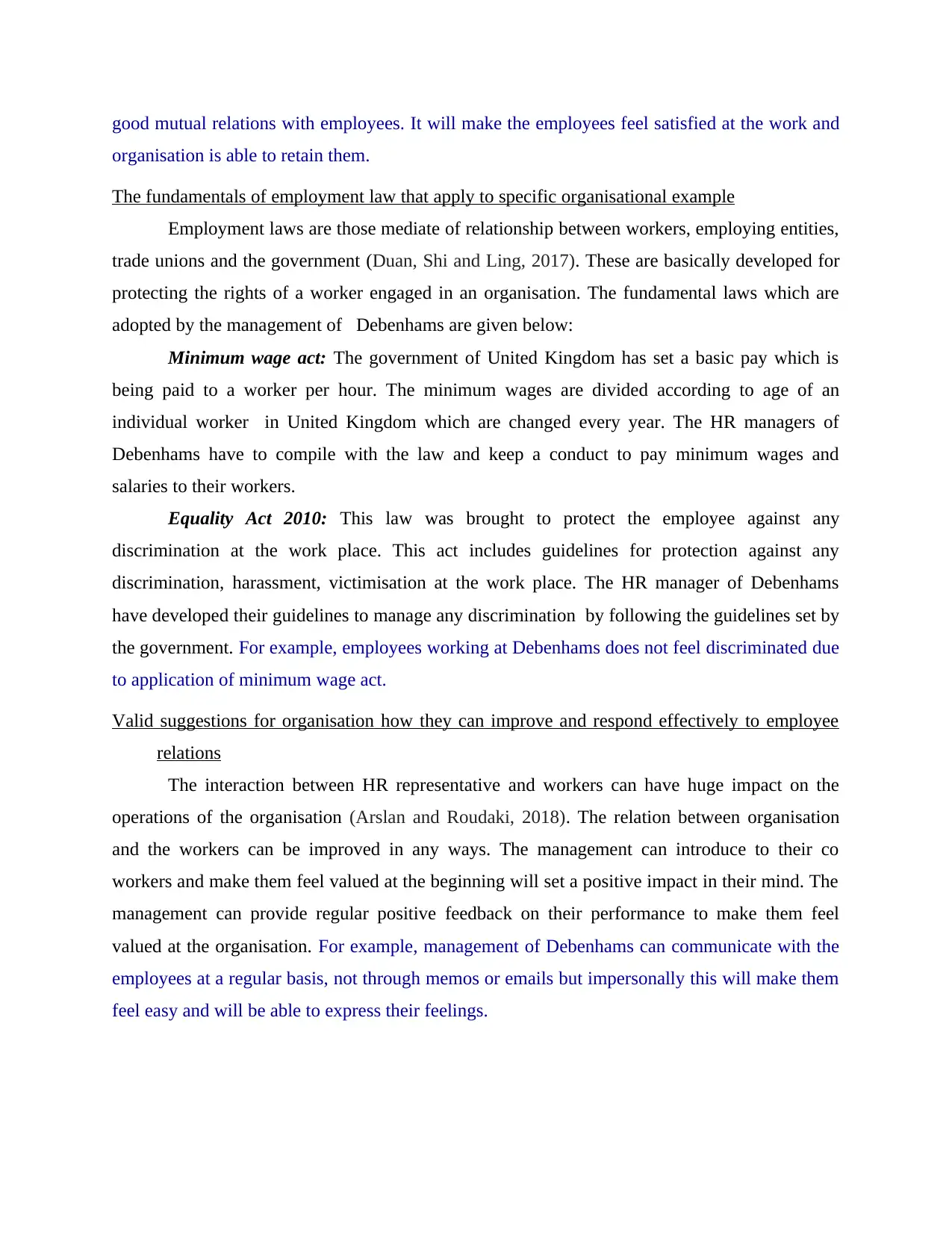
good mutual relations with employees. It will make the employees feel satisfied at the work and
organisation is able to retain them.
The fundamentals of employment law that apply to specific organisational example
Employment laws are those mediate of relationship between workers, employing entities,
trade unions and the government (Duan, Shi and Ling, 2017). These are basically developed for
protecting the rights of a worker engaged in an organisation. The fundamental laws which are
adopted by the management of Debenhams are given below:
Minimum wage act: The government of United Kingdom has set a basic pay which is
being paid to a worker per hour. The minimum wages are divided according to age of an
individual worker in United Kingdom which are changed every year. The HR managers of
Debenhams have to compile with the law and keep a conduct to pay minimum wages and
salaries to their workers.
Equality Act 2010: This law was brought to protect the employee against any
discrimination at the work place. This act includes guidelines for protection against any
discrimination, harassment, victimisation at the work place. The HR manager of Debenhams
have developed their guidelines to manage any discrimination by following the guidelines set by
the government. For example, employees working at Debenhams does not feel discriminated due
to application of minimum wage act.
Valid suggestions for organisation how they can improve and respond effectively to employee
relations
The interaction between HR representative and workers can have huge impact on the
operations of the organisation (Arslan and Roudaki, 2018). The relation between organisation
and the workers can be improved in any ways. The management can introduce to their co
workers and make them feel valued at the beginning will set a positive impact in their mind. The
management can provide regular positive feedback on their performance to make them feel
valued at the organisation. For example, management of Debenhams can communicate with the
employees at a regular basis, not through memos or emails but impersonally this will make them
feel easy and will be able to express their feelings.
organisation is able to retain them.
The fundamentals of employment law that apply to specific organisational example
Employment laws are those mediate of relationship between workers, employing entities,
trade unions and the government (Duan, Shi and Ling, 2017). These are basically developed for
protecting the rights of a worker engaged in an organisation. The fundamental laws which are
adopted by the management of Debenhams are given below:
Minimum wage act: The government of United Kingdom has set a basic pay which is
being paid to a worker per hour. The minimum wages are divided according to age of an
individual worker in United Kingdom which are changed every year. The HR managers of
Debenhams have to compile with the law and keep a conduct to pay minimum wages and
salaries to their workers.
Equality Act 2010: This law was brought to protect the employee against any
discrimination at the work place. This act includes guidelines for protection against any
discrimination, harassment, victimisation at the work place. The HR manager of Debenhams
have developed their guidelines to manage any discrimination by following the guidelines set by
the government. For example, employees working at Debenhams does not feel discriminated due
to application of minimum wage act.
Valid suggestions for organisation how they can improve and respond effectively to employee
relations
The interaction between HR representative and workers can have huge impact on the
operations of the organisation (Arslan and Roudaki, 2018). The relation between organisation
and the workers can be improved in any ways. The management can introduce to their co
workers and make them feel valued at the beginning will set a positive impact in their mind. The
management can provide regular positive feedback on their performance to make them feel
valued at the organisation. For example, management of Debenhams can communicate with the
employees at a regular basis, not through memos or emails but impersonally this will make them
feel easy and will be able to express their feelings.
Paraphrase This Document
Need a fresh take? Get an instant paraphrase of this document with our AI Paraphraser
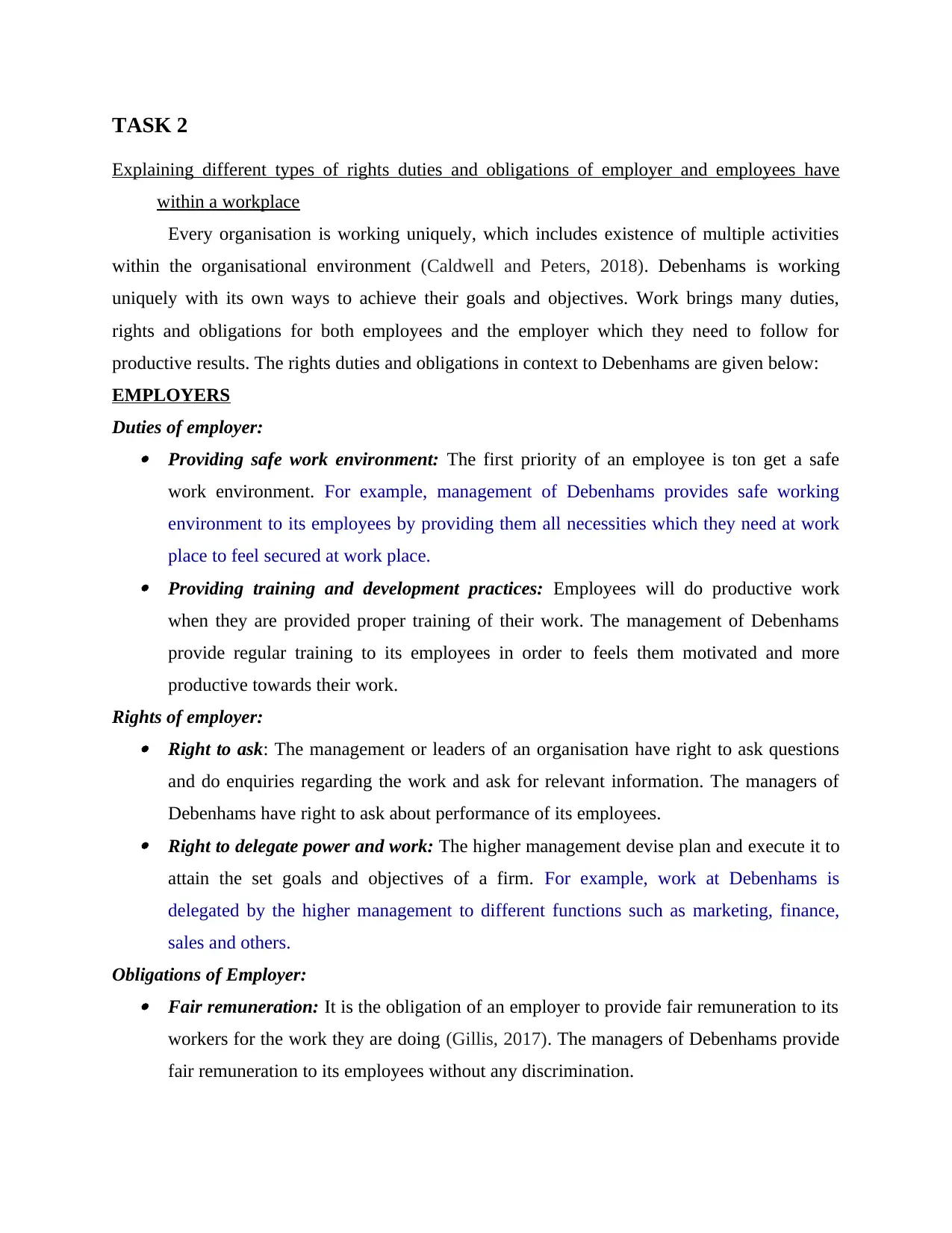
TASK 2
Explaining different types of rights duties and obligations of employer and employees have
within a workplace
Every organisation is working uniquely, which includes existence of multiple activities
within the organisational environment (Caldwell and Peters, 2018). Debenhams is working
uniquely with its own ways to achieve their goals and objectives. Work brings many duties,
rights and obligations for both employees and the employer which they need to follow for
productive results. The rights duties and obligations in context to Debenhams are given below:
EMPLOYERS
Duties of employer: Providing safe work environment: The first priority of an employee is ton get a safe
work environment. For example, management of Debenhams provides safe working
environment to its employees by providing them all necessities which they need at work
place to feel secured at work place. Providing training and development practices: Employees will do productive work
when they are provided proper training of their work. The management of Debenhams
provide regular training to its employees in order to feels them motivated and more
productive towards their work.
Rights of employer: Right to ask: The management or leaders of an organisation have right to ask questions
and do enquiries regarding the work and ask for relevant information. The managers of
Debenhams have right to ask about performance of its employees. Right to delegate power and work: The higher management devise plan and execute it to
attain the set goals and objectives of a firm. For example, work at Debenhams is
delegated by the higher management to different functions such as marketing, finance,
sales and others.
Obligations of Employer: Fair remuneration: It is the obligation of an employer to provide fair remuneration to its
workers for the work they are doing (Gillis, 2017). The managers of Debenhams provide
fair remuneration to its employees without any discrimination.
Explaining different types of rights duties and obligations of employer and employees have
within a workplace
Every organisation is working uniquely, which includes existence of multiple activities
within the organisational environment (Caldwell and Peters, 2018). Debenhams is working
uniquely with its own ways to achieve their goals and objectives. Work brings many duties,
rights and obligations for both employees and the employer which they need to follow for
productive results. The rights duties and obligations in context to Debenhams are given below:
EMPLOYERS
Duties of employer: Providing safe work environment: The first priority of an employee is ton get a safe
work environment. For example, management of Debenhams provides safe working
environment to its employees by providing them all necessities which they need at work
place to feel secured at work place. Providing training and development practices: Employees will do productive work
when they are provided proper training of their work. The management of Debenhams
provide regular training to its employees in order to feels them motivated and more
productive towards their work.
Rights of employer: Right to ask: The management or leaders of an organisation have right to ask questions
and do enquiries regarding the work and ask for relevant information. The managers of
Debenhams have right to ask about performance of its employees. Right to delegate power and work: The higher management devise plan and execute it to
attain the set goals and objectives of a firm. For example, work at Debenhams is
delegated by the higher management to different functions such as marketing, finance,
sales and others.
Obligations of Employer: Fair remuneration: It is the obligation of an employer to provide fair remuneration to its
workers for the work they are doing (Gillis, 2017). The managers of Debenhams provide
fair remuneration to its employees without any discrimination.
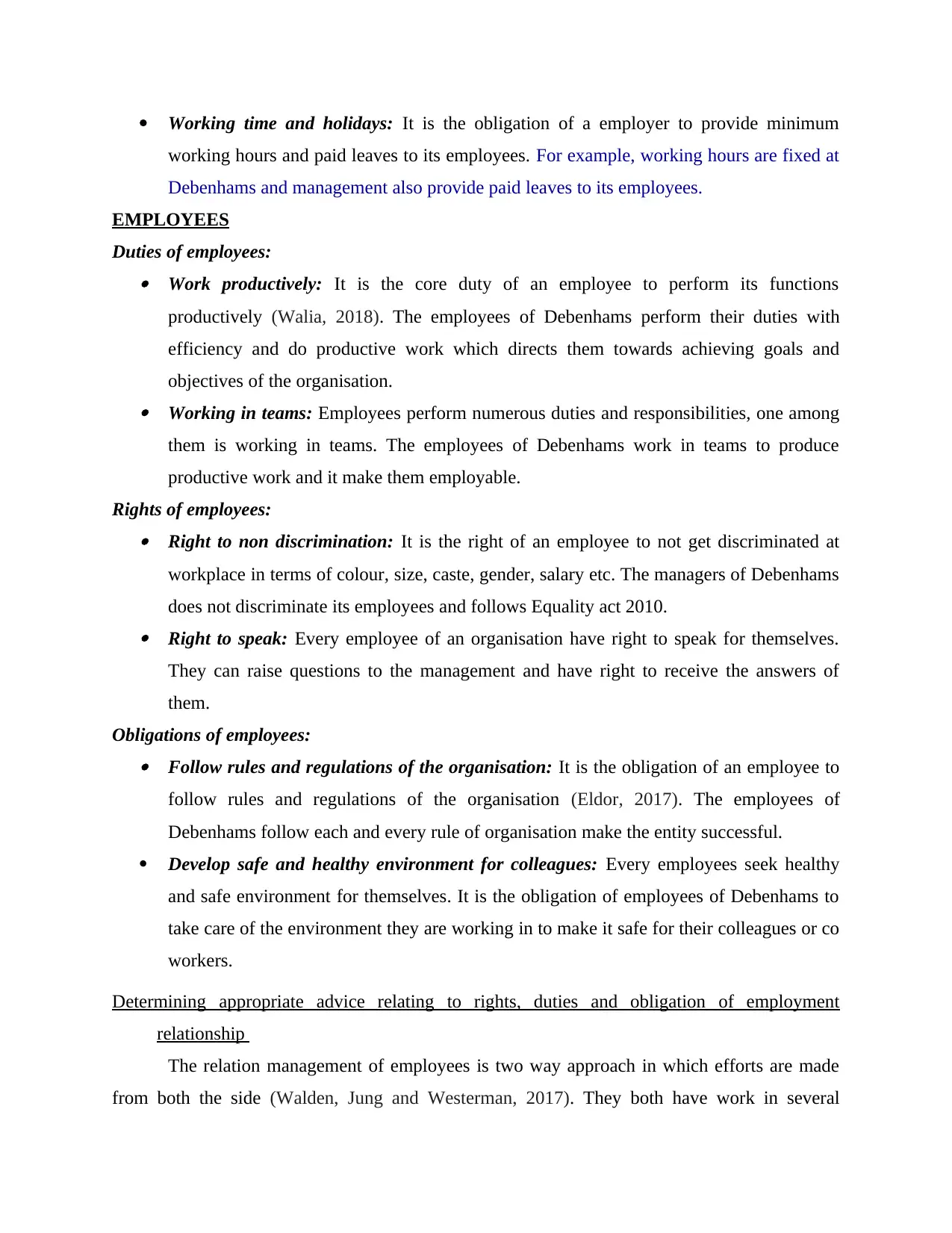
Working time and holidays: It is the obligation of a employer to provide minimum
working hours and paid leaves to its employees. For example, working hours are fixed at
Debenhams and management also provide paid leaves to its employees.
EMPLOYEES
Duties of employees: Work productively: It is the core duty of an employee to perform its functions
productively (Walia, 2018). The employees of Debenhams perform their duties with
efficiency and do productive work which directs them towards achieving goals and
objectives of the organisation. Working in teams: Employees perform numerous duties and responsibilities, one among
them is working in teams. The employees of Debenhams work in teams to produce
productive work and it make them employable.
Rights of employees: Right to non discrimination: It is the right of an employee to not get discriminated at
workplace in terms of colour, size, caste, gender, salary etc. The managers of Debenhams
does not discriminate its employees and follows Equality act 2010. Right to speak: Every employee of an organisation have right to speak for themselves.
They can raise questions to the management and have right to receive the answers of
them.
Obligations of employees: Follow rules and regulations of the organisation: It is the obligation of an employee to
follow rules and regulations of the organisation (Eldor, 2017). The employees of
Debenhams follow each and every rule of organisation make the entity successful.
Develop safe and healthy environment for colleagues: Every employees seek healthy
and safe environment for themselves. It is the obligation of employees of Debenhams to
take care of the environment they are working in to make it safe for their colleagues or co
workers.
Determining appropriate advice relating to rights, duties and obligation of employment
relationship
The relation management of employees is two way approach in which efforts are made
from both the side (Walden, Jung and Westerman, 2017). They both have work in several
working hours and paid leaves to its employees. For example, working hours are fixed at
Debenhams and management also provide paid leaves to its employees.
EMPLOYEES
Duties of employees: Work productively: It is the core duty of an employee to perform its functions
productively (Walia, 2018). The employees of Debenhams perform their duties with
efficiency and do productive work which directs them towards achieving goals and
objectives of the organisation. Working in teams: Employees perform numerous duties and responsibilities, one among
them is working in teams. The employees of Debenhams work in teams to produce
productive work and it make them employable.
Rights of employees: Right to non discrimination: It is the right of an employee to not get discriminated at
workplace in terms of colour, size, caste, gender, salary etc. The managers of Debenhams
does not discriminate its employees and follows Equality act 2010. Right to speak: Every employee of an organisation have right to speak for themselves.
They can raise questions to the management and have right to receive the answers of
them.
Obligations of employees: Follow rules and regulations of the organisation: It is the obligation of an employee to
follow rules and regulations of the organisation (Eldor, 2017). The employees of
Debenhams follow each and every rule of organisation make the entity successful.
Develop safe and healthy environment for colleagues: Every employees seek healthy
and safe environment for themselves. It is the obligation of employees of Debenhams to
take care of the environment they are working in to make it safe for their colleagues or co
workers.
Determining appropriate advice relating to rights, duties and obligation of employment
relationship
The relation management of employees is two way approach in which efforts are made
from both the side (Walden, Jung and Westerman, 2017). They both have work in several
⊘ This is a preview!⊘
Do you want full access?
Subscribe today to unlock all pages.

Trusted by 1+ million students worldwide
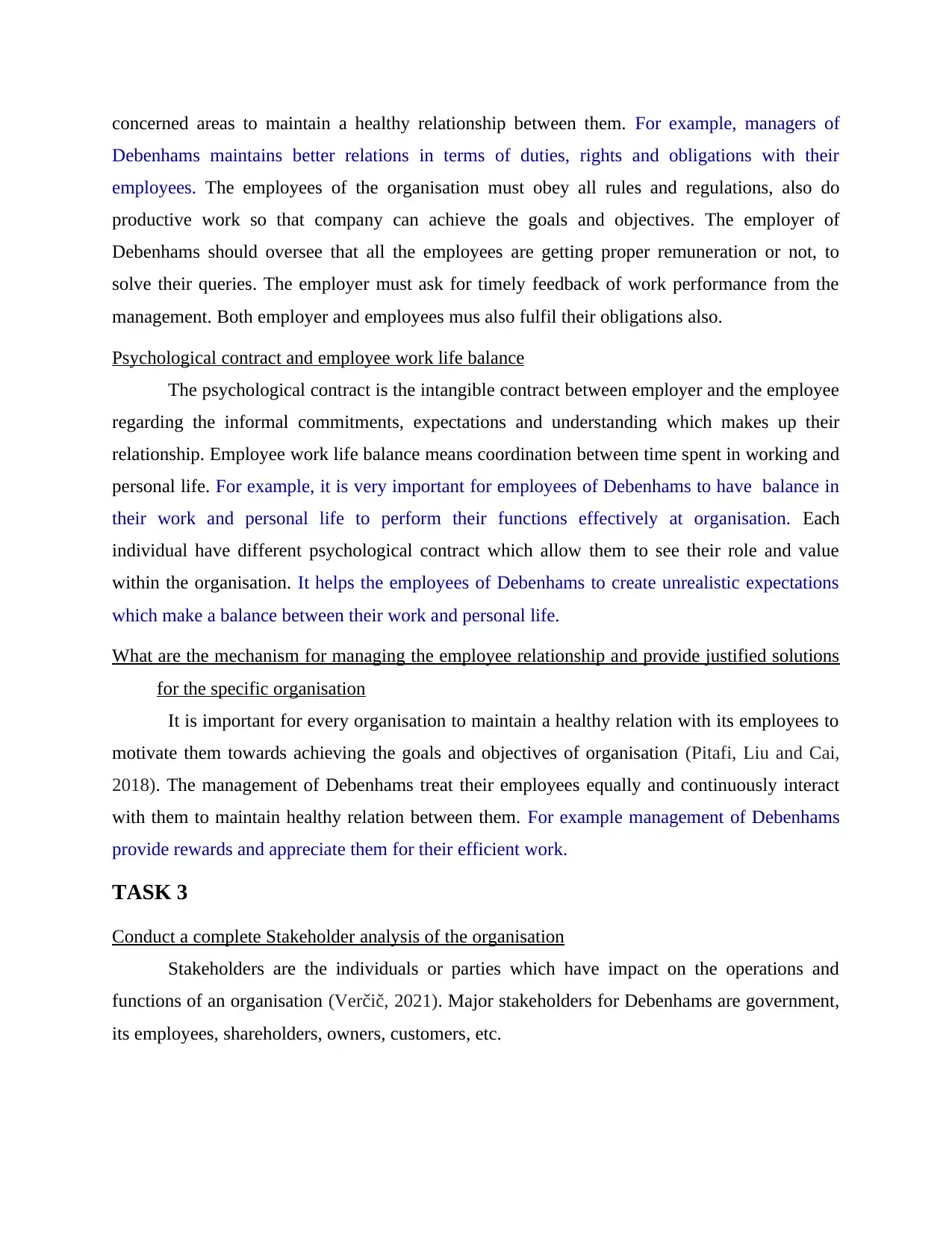
concerned areas to maintain a healthy relationship between them. For example, managers of
Debenhams maintains better relations in terms of duties, rights and obligations with their
employees. The employees of the organisation must obey all rules and regulations, also do
productive work so that company can achieve the goals and objectives. The employer of
Debenhams should oversee that all the employees are getting proper remuneration or not, to
solve their queries. The employer must ask for timely feedback of work performance from the
management. Both employer and employees mus also fulfil their obligations also.
Psychological contract and employee work life balance
The psychological contract is the intangible contract between employer and the employee
regarding the informal commitments, expectations and understanding which makes up their
relationship. Employee work life balance means coordination between time spent in working and
personal life. For example, it is very important for employees of Debenhams to have balance in
their work and personal life to perform their functions effectively at organisation. Each
individual have different psychological contract which allow them to see their role and value
within the organisation. It helps the employees of Debenhams to create unrealistic expectations
which make a balance between their work and personal life.
What are the mechanism for managing the employee relationship and provide justified solutions
for the specific organisation
It is important for every organisation to maintain a healthy relation with its employees to
motivate them towards achieving the goals and objectives of organisation (Pitafi, Liu and Cai,
2018). The management of Debenhams treat their employees equally and continuously interact
with them to maintain healthy relation between them. For example management of Debenhams
provide rewards and appreciate them for their efficient work.
TASK 3
Conduct a complete Stakeholder analysis of the organisation
Stakeholders are the individuals or parties which have impact on the operations and
functions of an organisation (Verčič, 2021). Major stakeholders for Debenhams are government,
its employees, shareholders, owners, customers, etc.
Debenhams maintains better relations in terms of duties, rights and obligations with their
employees. The employees of the organisation must obey all rules and regulations, also do
productive work so that company can achieve the goals and objectives. The employer of
Debenhams should oversee that all the employees are getting proper remuneration or not, to
solve their queries. The employer must ask for timely feedback of work performance from the
management. Both employer and employees mus also fulfil their obligations also.
Psychological contract and employee work life balance
The psychological contract is the intangible contract between employer and the employee
regarding the informal commitments, expectations and understanding which makes up their
relationship. Employee work life balance means coordination between time spent in working and
personal life. For example, it is very important for employees of Debenhams to have balance in
their work and personal life to perform their functions effectively at organisation. Each
individual have different psychological contract which allow them to see their role and value
within the organisation. It helps the employees of Debenhams to create unrealistic expectations
which make a balance between their work and personal life.
What are the mechanism for managing the employee relationship and provide justified solutions
for the specific organisation
It is important for every organisation to maintain a healthy relation with its employees to
motivate them towards achieving the goals and objectives of organisation (Pitafi, Liu and Cai,
2018). The management of Debenhams treat their employees equally and continuously interact
with them to maintain healthy relation between them. For example management of Debenhams
provide rewards and appreciate them for their efficient work.
TASK 3
Conduct a complete Stakeholder analysis of the organisation
Stakeholders are the individuals or parties which have impact on the operations and
functions of an organisation (Verčič, 2021). Major stakeholders for Debenhams are government,
its employees, shareholders, owners, customers, etc.
Paraphrase This Document
Need a fresh take? Get an instant paraphrase of this document with our AI Paraphraser
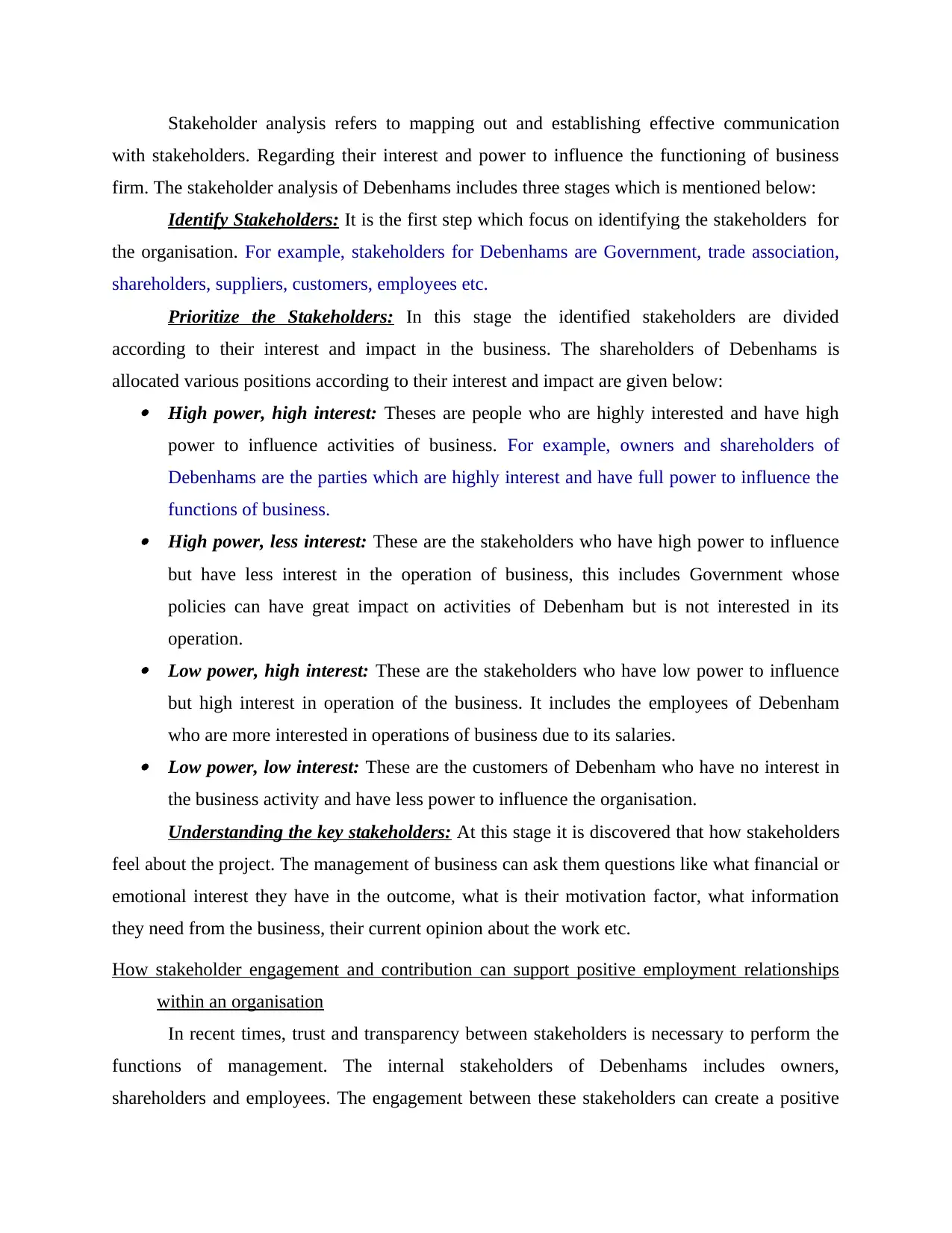
Stakeholder analysis refers to mapping out and establishing effective communication
with stakeholders. Regarding their interest and power to influence the functioning of business
firm. The stakeholder analysis of Debenhams includes three stages which is mentioned below:
Identify Stakeholders: It is the first step which focus on identifying the stakeholders for
the organisation. For example, stakeholders for Debenhams are Government, trade association,
shareholders, suppliers, customers, employees etc.
Prioritize the Stakeholders: In this stage the identified stakeholders are divided
according to their interest and impact in the business. The shareholders of Debenhams is
allocated various positions according to their interest and impact are given below: High power, high interest: Theses are people who are highly interested and have high
power to influence activities of business. For example, owners and shareholders of
Debenhams are the parties which are highly interest and have full power to influence the
functions of business. High power, less interest: These are the stakeholders who have high power to influence
but have less interest in the operation of business, this includes Government whose
policies can have great impact on activities of Debenham but is not interested in its
operation. Low power, high interest: These are the stakeholders who have low power to influence
but high interest in operation of the business. It includes the employees of Debenham
who are more interested in operations of business due to its salaries. Low power, low interest: These are the customers of Debenham who have no interest in
the business activity and have less power to influence the organisation.
Understanding the key stakeholders: At this stage it is discovered that how stakeholders
feel about the project. The management of business can ask them questions like what financial or
emotional interest they have in the outcome, what is their motivation factor, what information
they need from the business, their current opinion about the work etc.
How stakeholder engagement and contribution can support positive employment relationships
within an organisation
In recent times, trust and transparency between stakeholders is necessary to perform the
functions of management. The internal stakeholders of Debenhams includes owners,
shareholders and employees. The engagement between these stakeholders can create a positive
with stakeholders. Regarding their interest and power to influence the functioning of business
firm. The stakeholder analysis of Debenhams includes three stages which is mentioned below:
Identify Stakeholders: It is the first step which focus on identifying the stakeholders for
the organisation. For example, stakeholders for Debenhams are Government, trade association,
shareholders, suppliers, customers, employees etc.
Prioritize the Stakeholders: In this stage the identified stakeholders are divided
according to their interest and impact in the business. The shareholders of Debenhams is
allocated various positions according to their interest and impact are given below: High power, high interest: Theses are people who are highly interested and have high
power to influence activities of business. For example, owners and shareholders of
Debenhams are the parties which are highly interest and have full power to influence the
functions of business. High power, less interest: These are the stakeholders who have high power to influence
but have less interest in the operation of business, this includes Government whose
policies can have great impact on activities of Debenham but is not interested in its
operation. Low power, high interest: These are the stakeholders who have low power to influence
but high interest in operation of the business. It includes the employees of Debenham
who are more interested in operations of business due to its salaries. Low power, low interest: These are the customers of Debenham who have no interest in
the business activity and have less power to influence the organisation.
Understanding the key stakeholders: At this stage it is discovered that how stakeholders
feel about the project. The management of business can ask them questions like what financial or
emotional interest they have in the outcome, what is their motivation factor, what information
they need from the business, their current opinion about the work etc.
How stakeholder engagement and contribution can support positive employment relationships
within an organisation
In recent times, trust and transparency between stakeholders is necessary to perform the
functions of management. The internal stakeholders of Debenhams includes owners,
shareholders and employees. The engagement between these stakeholders can create a positive
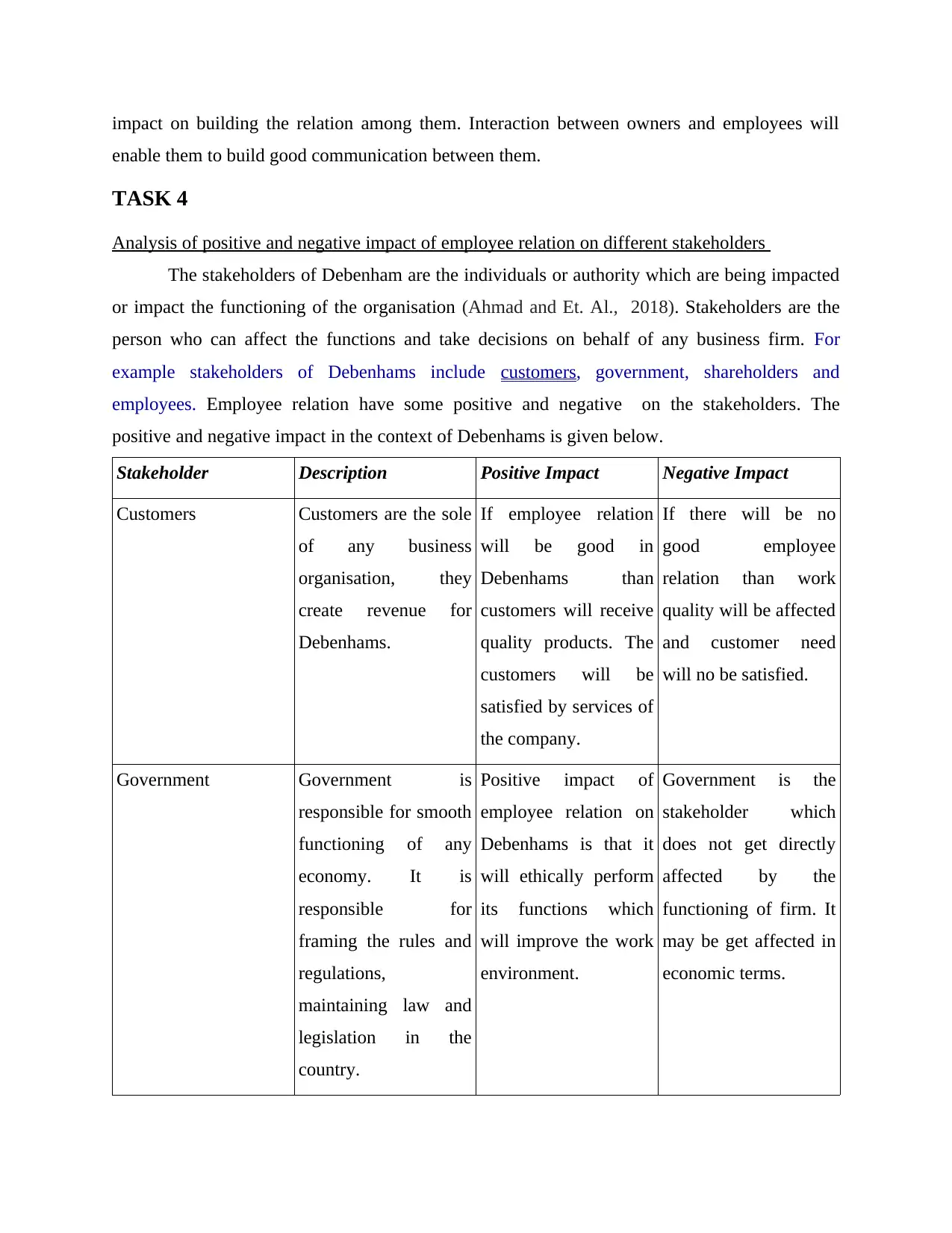
impact on building the relation among them. Interaction between owners and employees will
enable them to build good communication between them.
TASK 4
Analysis of positive and negative impact of employee relation on different stakeholders
The stakeholders of Debenham are the individuals or authority which are being impacted
or impact the functioning of the organisation (Ahmad and Et. Al., 2018). Stakeholders are the
person who can affect the functions and take decisions on behalf of any business firm. For
example stakeholders of Debenhams include customers, government, shareholders and
employees. Employee relation have some positive and negative on the stakeholders. The
positive and negative impact in the context of Debenhams is given below.
Stakeholder Description Positive Impact Negative Impact
Customers Customers are the sole
of any business
organisation, they
create revenue for
Debenhams.
If employee relation
will be good in
Debenhams than
customers will receive
quality products. The
customers will be
satisfied by services of
the company.
If there will be no
good employee
relation than work
quality will be affected
and customer need
will no be satisfied.
Government Government is
responsible for smooth
functioning of any
economy. It is
responsible for
framing the rules and
regulations,
maintaining law and
legislation in the
country.
Positive impact of
employee relation on
Debenhams is that it
will ethically perform
its functions which
will improve the work
environment.
Government is the
stakeholder which
does not get directly
affected by the
functioning of firm. It
may be get affected in
economic terms.
enable them to build good communication between them.
TASK 4
Analysis of positive and negative impact of employee relation on different stakeholders
The stakeholders of Debenham are the individuals or authority which are being impacted
or impact the functioning of the organisation (Ahmad and Et. Al., 2018). Stakeholders are the
person who can affect the functions and take decisions on behalf of any business firm. For
example stakeholders of Debenhams include customers, government, shareholders and
employees. Employee relation have some positive and negative on the stakeholders. The
positive and negative impact in the context of Debenhams is given below.
Stakeholder Description Positive Impact Negative Impact
Customers Customers are the sole
of any business
organisation, they
create revenue for
Debenhams.
If employee relation
will be good in
Debenhams than
customers will receive
quality products. The
customers will be
satisfied by services of
the company.
If there will be no
good employee
relation than work
quality will be affected
and customer need
will no be satisfied.
Government Government is
responsible for smooth
functioning of any
economy. It is
responsible for
framing the rules and
regulations,
maintaining law and
legislation in the
country.
Positive impact of
employee relation on
Debenhams is that it
will ethically perform
its functions which
will improve the work
environment.
Government is the
stakeholder which
does not get directly
affected by the
functioning of firm. It
may be get affected in
economic terms.
⊘ This is a preview!⊘
Do you want full access?
Subscribe today to unlock all pages.

Trusted by 1+ million students worldwide
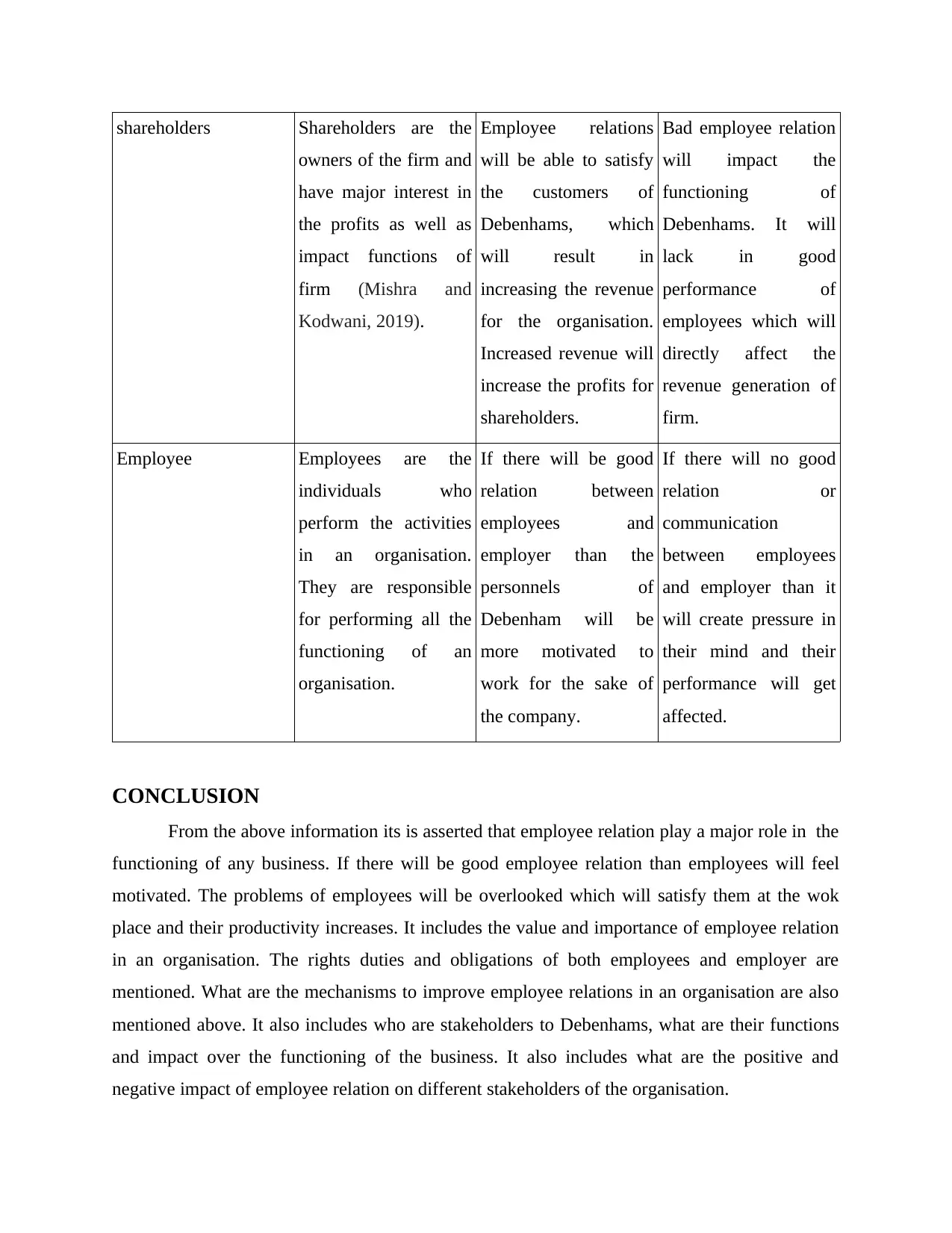
shareholders Shareholders are the
owners of the firm and
have major interest in
the profits as well as
impact functions of
firm (Mishra and
Kodwani, 2019).
Employee relations
will be able to satisfy
the customers of
Debenhams, which
will result in
increasing the revenue
for the organisation.
Increased revenue will
increase the profits for
shareholders.
Bad employee relation
will impact the
functioning of
Debenhams. It will
lack in good
performance of
employees which will
directly affect the
revenue generation of
firm.
Employee Employees are the
individuals who
perform the activities
in an organisation.
They are responsible
for performing all the
functioning of an
organisation.
If there will be good
relation between
employees and
employer than the
personnels of
Debenham will be
more motivated to
work for the sake of
the company.
If there will no good
relation or
communication
between employees
and employer than it
will create pressure in
their mind and their
performance will get
affected.
CONCLUSION
From the above information its is asserted that employee relation play a major role in the
functioning of any business. If there will be good employee relation than employees will feel
motivated. The problems of employees will be overlooked which will satisfy them at the wok
place and their productivity increases. It includes the value and importance of employee relation
in an organisation. The rights duties and obligations of both employees and employer are
mentioned. What are the mechanisms to improve employee relations in an organisation are also
mentioned above. It also includes who are stakeholders to Debenhams, what are their functions
and impact over the functioning of the business. It also includes what are the positive and
negative impact of employee relation on different stakeholders of the organisation.
owners of the firm and
have major interest in
the profits as well as
impact functions of
firm (Mishra and
Kodwani, 2019).
Employee relations
will be able to satisfy
the customers of
Debenhams, which
will result in
increasing the revenue
for the organisation.
Increased revenue will
increase the profits for
shareholders.
Bad employee relation
will impact the
functioning of
Debenhams. It will
lack in good
performance of
employees which will
directly affect the
revenue generation of
firm.
Employee Employees are the
individuals who
perform the activities
in an organisation.
They are responsible
for performing all the
functioning of an
organisation.
If there will be good
relation between
employees and
employer than the
personnels of
Debenham will be
more motivated to
work for the sake of
the company.
If there will no good
relation or
communication
between employees
and employer than it
will create pressure in
their mind and their
performance will get
affected.
CONCLUSION
From the above information its is asserted that employee relation play a major role in the
functioning of any business. If there will be good employee relation than employees will feel
motivated. The problems of employees will be overlooked which will satisfy them at the wok
place and their productivity increases. It includes the value and importance of employee relation
in an organisation. The rights duties and obligations of both employees and employer are
mentioned. What are the mechanisms to improve employee relations in an organisation are also
mentioned above. It also includes who are stakeholders to Debenhams, what are their functions
and impact over the functioning of the business. It also includes what are the positive and
negative impact of employee relation on different stakeholders of the organisation.
Paraphrase This Document
Need a fresh take? Get an instant paraphrase of this document with our AI Paraphraser

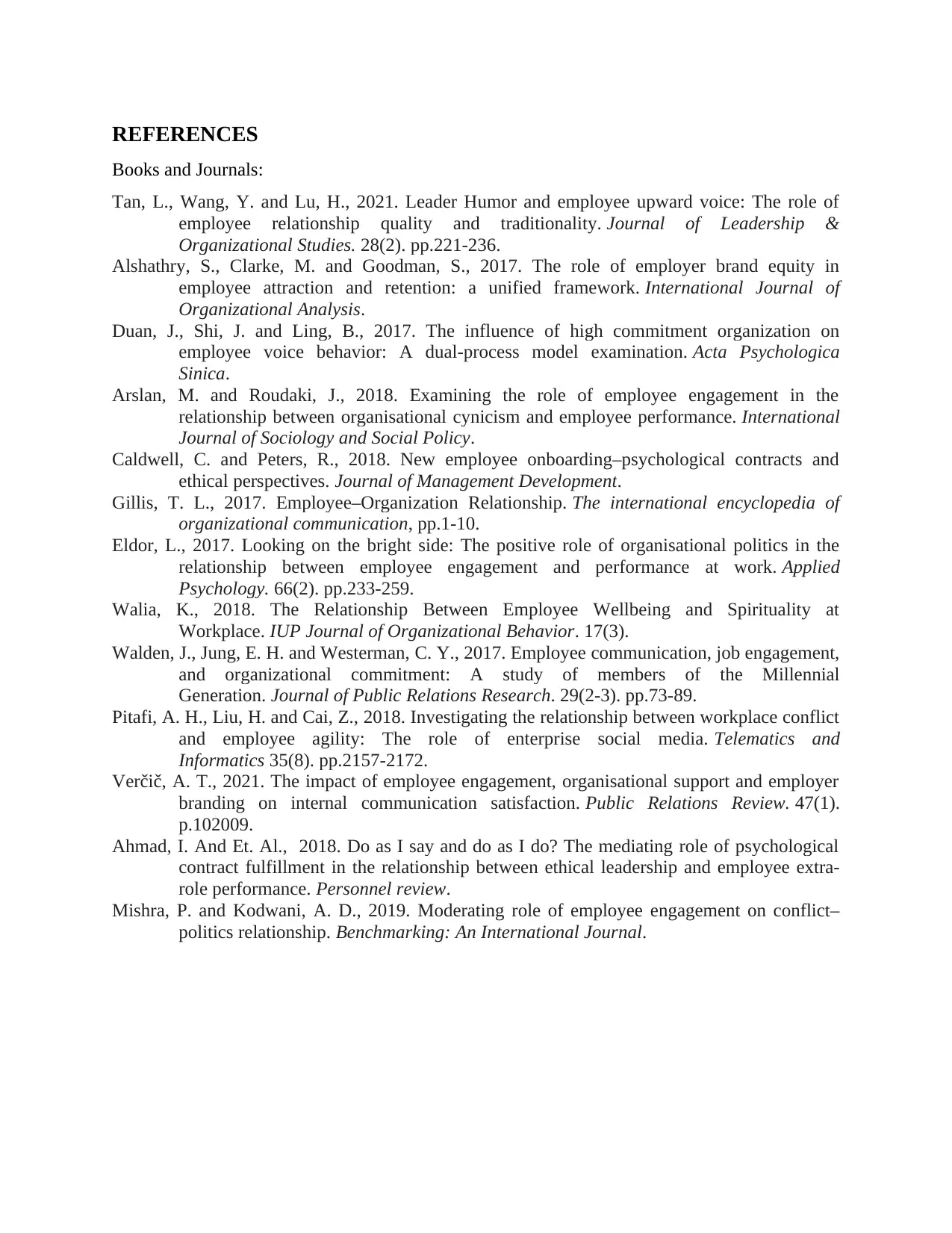
REFERENCES
Books and Journals:
Tan, L., Wang, Y. and Lu, H., 2021. Leader Humor and employee upward voice: The role of
employee relationship quality and traditionality. Journal of Leadership &
Organizational Studies. 28(2). pp.221-236.
Alshathry, S., Clarke, M. and Goodman, S., 2017. The role of employer brand equity in
employee attraction and retention: a unified framework. International Journal of
Organizational Analysis.
Duan, J., Shi, J. and Ling, B., 2017. The influence of high commitment organization on
employee voice behavior: A dual-process model examination. Acta Psychologica
Sinica.
Arslan, M. and Roudaki, J., 2018. Examining the role of employee engagement in the
relationship between organisational cynicism and employee performance. International
Journal of Sociology and Social Policy.
Caldwell, C. and Peters, R., 2018. New employee onboarding–psychological contracts and
ethical perspectives. Journal of Management Development.
Gillis, T. L., 2017. Employee–Organization Relationship. The international encyclopedia of
organizational communication, pp.1-10.
Eldor, L., 2017. Looking on the bright side: The positive role of organisational politics in the
relationship between employee engagement and performance at work. Applied
Psychology. 66(2). pp.233-259.
Walia, K., 2018. The Relationship Between Employee Wellbeing and Spirituality at
Workplace. IUP Journal of Organizational Behavior. 17(3).
Walden, J., Jung, E. H. and Westerman, C. Y., 2017. Employee communication, job engagement,
and organizational commitment: A study of members of the Millennial
Generation. Journal of Public Relations Research. 29(2-3). pp.73-89.
Pitafi, A. H., Liu, H. and Cai, Z., 2018. Investigating the relationship between workplace conflict
and employee agility: The role of enterprise social media. Telematics and
Informatics 35(8). pp.2157-2172.
Verčič, A. T., 2021. The impact of employee engagement, organisational support and employer
branding on internal communication satisfaction. Public Relations Review. 47(1).
p.102009.
Ahmad, I. And Et. Al., 2018. Do as I say and do as I do? The mediating role of psychological
contract fulfillment in the relationship between ethical leadership and employee extra-
role performance. Personnel review.
Mishra, P. and Kodwani, A. D., 2019. Moderating role of employee engagement on conflict–
politics relationship. Benchmarking: An International Journal.
Books and Journals:
Tan, L., Wang, Y. and Lu, H., 2021. Leader Humor and employee upward voice: The role of
employee relationship quality and traditionality. Journal of Leadership &
Organizational Studies. 28(2). pp.221-236.
Alshathry, S., Clarke, M. and Goodman, S., 2017. The role of employer brand equity in
employee attraction and retention: a unified framework. International Journal of
Organizational Analysis.
Duan, J., Shi, J. and Ling, B., 2017. The influence of high commitment organization on
employee voice behavior: A dual-process model examination. Acta Psychologica
Sinica.
Arslan, M. and Roudaki, J., 2018. Examining the role of employee engagement in the
relationship between organisational cynicism and employee performance. International
Journal of Sociology and Social Policy.
Caldwell, C. and Peters, R., 2018. New employee onboarding–psychological contracts and
ethical perspectives. Journal of Management Development.
Gillis, T. L., 2017. Employee–Organization Relationship. The international encyclopedia of
organizational communication, pp.1-10.
Eldor, L., 2017. Looking on the bright side: The positive role of organisational politics in the
relationship between employee engagement and performance at work. Applied
Psychology. 66(2). pp.233-259.
Walia, K., 2018. The Relationship Between Employee Wellbeing and Spirituality at
Workplace. IUP Journal of Organizational Behavior. 17(3).
Walden, J., Jung, E. H. and Westerman, C. Y., 2017. Employee communication, job engagement,
and organizational commitment: A study of members of the Millennial
Generation. Journal of Public Relations Research. 29(2-3). pp.73-89.
Pitafi, A. H., Liu, H. and Cai, Z., 2018. Investigating the relationship between workplace conflict
and employee agility: The role of enterprise social media. Telematics and
Informatics 35(8). pp.2157-2172.
Verčič, A. T., 2021. The impact of employee engagement, organisational support and employer
branding on internal communication satisfaction. Public Relations Review. 47(1).
p.102009.
Ahmad, I. And Et. Al., 2018. Do as I say and do as I do? The mediating role of psychological
contract fulfillment in the relationship between ethical leadership and employee extra-
role performance. Personnel review.
Mishra, P. and Kodwani, A. D., 2019. Moderating role of employee engagement on conflict–
politics relationship. Benchmarking: An International Journal.
⊘ This is a preview!⊘
Do you want full access?
Subscribe today to unlock all pages.

Trusted by 1+ million students worldwide
1 out of 12
Related Documents
Your All-in-One AI-Powered Toolkit for Academic Success.
+13062052269
info@desklib.com
Available 24*7 on WhatsApp / Email
![[object Object]](/_next/static/media/star-bottom.7253800d.svg)
Unlock your academic potential
Copyright © 2020–2025 A2Z Services. All Rights Reserved. Developed and managed by ZUCOL.




